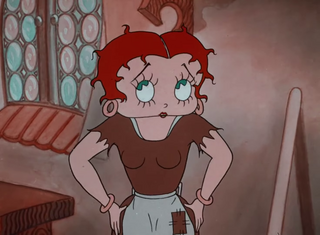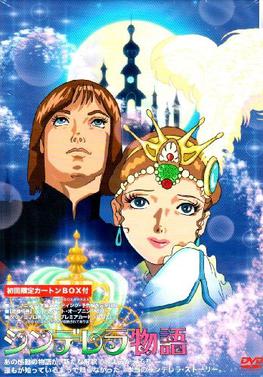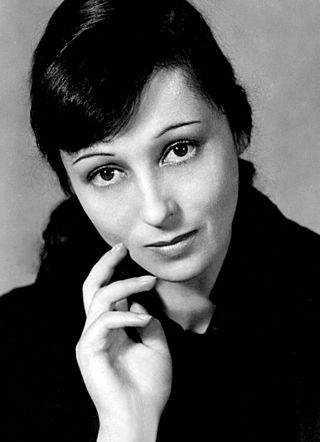External links
| | This article related to a short animated film is a stub. You can help Wikipedia by expanding it. |
| Cinderella Blues | |
|---|---|
| Directed by | John Foster Harry Bailey |
| Based on | Cinderella by Charles Perrault |
| Produced by | Amadee J. van Beuren |
| Color process | Black and white |
Production company | Van Beuren Studios |
| Distributed by | RKO Radio Pictures |
Release date |
|
Running time | 8:06 |
| Language | English |
Cinderella Blues is an animated short subject produced by the Van Beuren Studio and distributed by RKO Radio Pictures. It retells the Cinderella story by Charles Perrault. Unlike most adaptations, the cartoon features a fabled version of the story.
A weepy feline Cinderella sits around in her murky house. Cinderella, or Cindy which she is sometimes called, hardly does anything other than household work under the authority of her bossy old stepmother. She also longs for a more pleasant livelihood.
While standing in the living room one day, a pixie appears and asks Cindy if she would like to go to the ball. Cindy expresses interest but laments she has nothing to wear. The pixie puts forth a wand and transforms her rag outfit into a fancy dress. A luxury car with classy chauffeurs also appears, and the delighted young girl cat goes aboard.
The ball appears to be inside a castle. Cindy's date turns out to the prince, who is dressed like a 16th-century Spaniard. They then walk to the main room, where musicians and other dancing guests are in attendance. After dancing, they head to a backyard which is like a forest. When the prince kisses her twice, Cindy merrily starts distancing herself and goes to hide in the trees. While the prince struggles to find her, Cindy heads to a nearby clock, therefore finding out she has to leave immediately. As she flees, one of her shoes slips off and is left behind. The shoe is momentarily picked up by the prince, who arrives at the scene.
Cindy leaves in her car, attempting to reach home, but when midnight strikes, she is reverted to her old rag clothing, and her once-luxurious vehicle is reduced to some 1890s Daimler model, with her being the one driving it. The car momentarily breaks down, prompting Cindy to run on foot. While she goes on running, an anchor lowers and picks her up. It appears the one who lifted her is the prince, who is on a helicopter. The prince then holds out the shoe he found, and places it on Cindy's foot. As a miracle, Cindy is in her fancy dress again. They then kiss each other and fly back to the castle.

"Cinderella", or "The Little Glass Slipper", is a folk tale with thousands of variants that are told throughout the world. The protagonist is a young girl living in forsaken circumstances that are suddenly changed to remarkable fortune, with her ascension to the throne via marriage. The story of Rhodopis, recounted by the Greek geographer Strabo sometime between 7 BC and 23 AD, about a Greek slave girl who marries the king of Egypt, is usually considered to be the earliest known variant of the Cinderella story.
Cinderella Op. 87, is a ballet composed by Sergei Prokofiev to a scenario by Nikolai Volkov. It is one of his most popular and melodious compositions, and has inspired a great many choreographers since its inception. The piece was composed between 1940 and 1944. Part way through writing it Prokofiev broke off to write his opera War and Peace. The premiere of Cinderella was conducted by Yuri Fayer on 21 November, 1945, at the Bolshoi Theatre, with choreography by Rostislav Zakharov and Galina Ulanova in the title role. Cinderella is notable for its jubilant music, lush scenery, and for the comic double-roles of the stepmother and the two stepsisters, more mad than bad in this treatment.

Cinderella is a 1950 American animated musical fantasy film produced by Walt Disney Productions and released by RKO Radio Pictures. Based on Charles Perrault's 1697 fairy tale, it features supervision by Ben Sharpsteen. The film was directed by Wilfred Jackson, Hamilton Luske, and Clyde Geronimi. The film features the voices of Ilene Woods, Eleanor Audley, Verna Felton, Rhoda Williams, James MacDonald, and Luis van Rooten.

The Slipper and the Rose: The Story of Cinderella is a 1976 British musical retelling the classic fairy tale of Cinderella. The film was chosen as the Royal Command Performance motion picture selection for 1976.

"Allerleirauh" is a fairy tale recorded by the Brothers Grimm. Since the second edition published in 1819, it has been recorded as Tale no. 65. Andrew Lang included it in The Green Fairy Book.

"Katie Woodencloak" or "Kari Woodengown" is a Norwegian fairy tale collected by Peter Christen Asbjørnsen and Jørgen Moe in Norske Folkeeventyr. Andrew Lang included it in The Red Fairy Book.

"Donkeyskin" is a French literary fairytale written in verse by Charles Perrault. It was first published in 1695 in a small volume and republished in 1697 in Perrault's Histoires ou contes du temps passé. Andrew Lang included it, somewhat euphemized, in The Grey Fairy Book. It is classed among folktales of Aarne-Thompson type 510B, unnatural love.

Finette Cendron is a French literary fairy tale written by Madame d'Aulnoy.

Poor Cinderella is a 1934 Fleischer Studios-animated short film featuring Betty Boop. Poor Cinderella was Fleischer Studios' first color film, and the only appearance of Betty Boop in color during the Fleischer era. It was the first Paramount Pictures animated short in color.

Cinderella is a ballet-féerie in three acts, with the choreography of Enrico Cecchetti and Lev Ivanov supervised by Marius Petipa. Music is by Baron Boris Fitinhoff-Schell; the libretto is by Lidia Pashkova and Ivan Vsevolozhsky. It was first presented by the Imperial Ballet on 17 December [O.S. 5 December] 1893 at the Imperial Mariinsky Theatre in St. Petersburg, Russian Empire.

The Magic Riddle is a 1991 Australian animated musical feature film written and directed by Yoram Gross. The film tells the story of Cindy, an orphan who lives as an indentured servant to her cruel stepmother, and features elements of famous fairytales including Cinderella, Snow White and the Seven Dwarfs, Little Red Riding Hood, Sleeping Beauty and Pinocchio. Robyn Moore provides the voice of Cindy and various other characters. It was panned by critics, and accused of borrowing from several other Disney films.

Cinderella is an Italian-Japanese 1996 anime television series based on the fairytale of the same name by Charles Perrault and The Brothers Grimm. It was produced by Tatsunoko Productions and Mondo TV. The series originally aired from April 4 to October 3, 1996, comprising 26 episodes.

Hey, Cinderella! is a 1969 television special adaptation of the fairy tale Cinderella, produced by Muppets, Inc. in the United States and Robert Lawrence Productions in Canada, and featuring The Muppets created by Jim Henson, who also directed the special. It was written by Jon Stone and Tom Whedon, and scored by the music composer of Sesame Street, Joe Raposo. It featured Kermit in his first appearance as a frog, as well as Goshposh and Rufus and Splurge.
Kongjwi and Patjwi is a traditional Korean romance story from the Joseon Dynasty. It is the story of humble Kongji's triumph over adversity. The moral of the story is that virtuous people who think positively and work diligently will be happy, encapsulating the Western proverb "heaven helps those who help themselves."

Cinderella is a 1914 silent film starring Mary Pickford, directed by James Kirkwood Sr., produced by Daniel Frohman, and released by Famous Players Film Company. The film is based upon the fairy tale Cinderella. The film was released on Blu-ray & DVD as a bonus feature from the DVD of Through the Back Door (1921). It was previously released on DVD by Alpha Video.

A Kiss for Cinderella is a play by J. M. Barrie. It was first produced in London at Wyndham's Theatre on March 16, 1916, starring Gerald du Maurier and Hilda Trevelyan, enjoying great success over 156 performances, and with several annual Christmastime revivals.

Ash is a young adult fantasy children's novel by Malinda Lo first published in 2009. It is a reworking of the Cinderella fairy tale that reimagines the title character, Ash, as a lesbian teenager. The novel centers around the familiar story of Cinderella, her father recently remarried, and lamenting the misery of her new life with stepsisters and a stepmother. The twist arrives when Ash falls in love with the King's respected huntress Kaisa, after she has made a commitment to dark fairy prince Sidhean.
"Grimm Job" is the tenth episode of the twelfth season of the animated comedy series Family Guy and the 220th episode overall. It originally aired on Fox in the United States and Canada on January 12, 2014, and was directed by Joe Vaux and written by Alec Sulkin.

Revolting Rhymes is a 2016 British computer-animated fantasy comedy drama television film written for the screen and directed by Jakob Schuh and Jan Lachauer, based on the 1982 book of the same name written by Roald Dahl and illustrated by Quentin Blake.